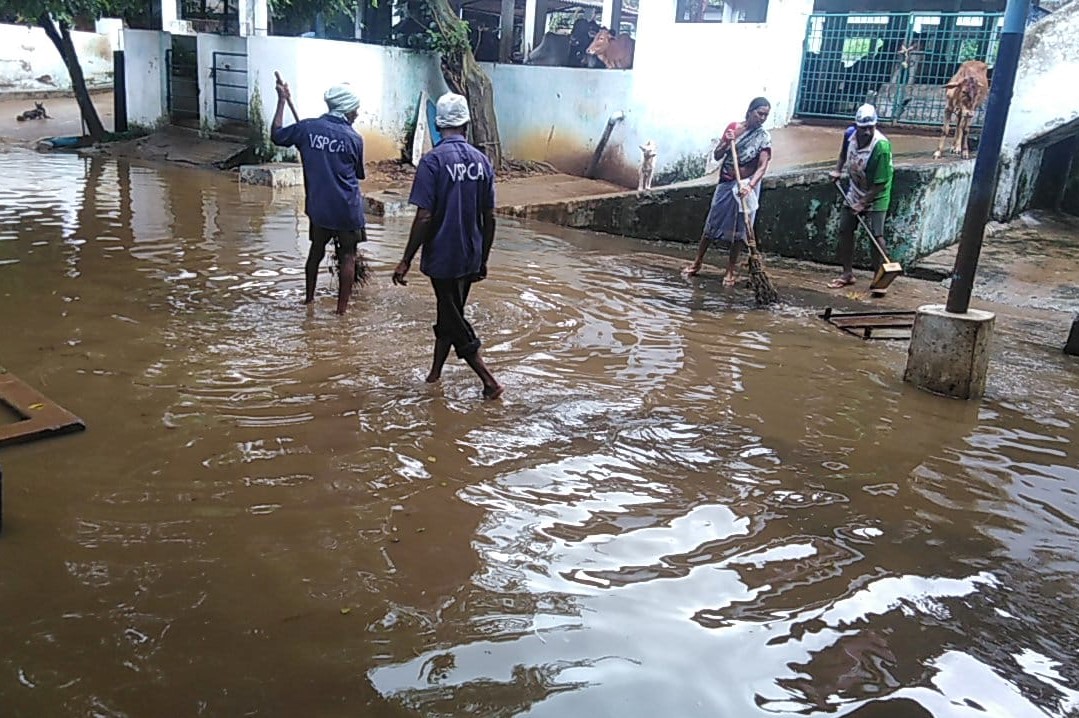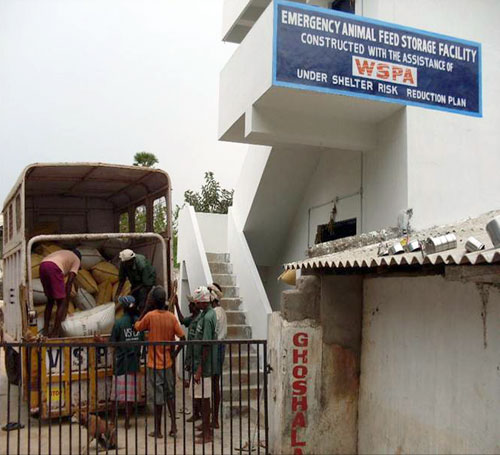
Disaster Risk Reduction and Flood Relief
Our city of Visakhapatnam is prone to cyclones each year. VSPCA has the immediate jurisdiction for 400 Kms of the interior and the coastline of 1000 Kms of our state of Andhra Pradesh. Additionally, the government authorities send us animals that are legally seized due to abuse. Under all these circumstances, we are always overburdened, overworked and overcrowded with all kinds of different animals under the various conditions of cruelties and distress. On any given day we cater to 611 cattle, 220 dogs, 83 cats, 40 daily operations under the Animal Birth Control program for Dogs & Cats, rescue of wild animals and upkeep of 11 monkeys, 34 star tortoises, 124 birds, 15 rabbits, 6 mice, 8 Guinea Pigs, 6 crows, 3 horses, and 2 hens. These are all kept well in our less than 3 acres of land.
Our shelter is just 8 km away from the Bay of Bengal where the cyclones come in and that is why we have prepared a blueprint of a comprehensive Risk Reduction Plan for our busy hospital. During the time of heavy monsoon rains and cyclones, we have the threat of flooding of our shelter which can be to the extent of 4 to 6 feet of stagnant water. Our shelter is in a bowel shape, so much of it is in an area of a water collecting point. Also, we are surrounded by streams that come in from all sides. These water sources can flow at tremendous speed raising to a height of 8 feet with a width of 15 feet. During these times eventually, they overrun our shelter.
Therefore, we are always apprehensive about the safety of the animals of our shelter even during normal monsoon times. Although we have already spent a lot of money on developing our drainage system we are far from solving the problem. We would like to develop our disaster plans further to include a better drainage system, our boundary wall raised up to five feet, structures to keep wildlife safer, and to have on hand emergency materials such as mobile generators, torches, shovels, industrial equipment, raincoats, rain boots, helmets, flashlights.

Feed storage building
WSPA has generously provided us a grant so that we were able to build the specially designed storage room that will contain buffer stocks and medicines for 1000 different animals. (Shown above.)
The building is able to stock fresh feed and medicines up to 6 tonnes of cattle feed which can be kept hygienic and safe as it is 4 feet above ground level. It is of great assistance to all our animals’ helpers as it is centralized, well planned and easy to load/unload.
Flood Relief
In September – October 2008, VSPCA was hard at work helping our neighbours to the north in the state of Orissa, site of the worst flooding in 50 years. Our team entered areas where there is no culture of helping non-property animals – where animals matter strictly for their practical value to people. This afforded us a priceless opportunity to spread our message of compassion for all animals to the villagers whom we have helped to not only care for their animals but also the street dogs and cats. Unlike other disaster efforts, we are had good coordination with the government and other NGOs for the best help to animals and also for the families that care for them by providing some basic necessities — as the floods left them with nothing.
We want to show you what we see and feel as we bring life-saving relief to Orissa, a beautiful region of rural India.
View our photo diary from the field as clickable thumbnails or view the full-screen slideshow (click on “info on” at the top to see captions).
A note on our philosophy when doing natural disaster relief
VSPCA believes that no animal should ever be used for food, profit or any other purpose detrimental to the animal’s life and well-being. However, in situations such as those in Orissa, we believe the best ethical choice is to do as much as possible to prevent the death and relieve the suffering of farmed animals and other “livestock.” Unlike high-profile development agencies, we try to save every life-threatened farm animal when disaster strikes, not abandon and replace them. Through our interventions, we strive to set an example of compassion that will bring better conditions to animals today and in the years to come.

